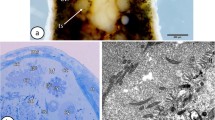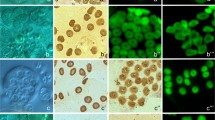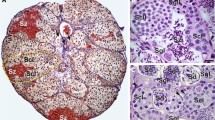Summary
The testis structure of the two genera described here shows that it conforms to the plan outlined forIchthyophis glutinosus andUrœotyphlus narayani except that inDermophis gregorii very few testis lobes were seen. The testis locules are smaller inSiphonops annulatus when compared with those of the other three genera. The locules are filled with a matrix which inIchthyophis andUrœotyphlus were determined as containing fat. In this matrix are embedded the germ cells in groups in different stages of spermatogenesis. The primary spermatogonia are found at the mouth of the duct in the locule and are believed to have arisen, as inIchthyophis, from the cells lining the duct epithelium. Their nuclei may be spherical or polymorphic, the latter condition indicating a high degree of metabolic activity. Just before division, however, the nucleus resumes its spherical or oval contour. After a number of divisions, varying between six and eight, the cells,—now primary spermatocytes,—embark on the meiotic phase after a brief period of rest. The leptote ne and pachy tene stages follow, after which, the nucleus is marked by a ‘diffuse’ condition in which the chromosome bivalents lose their identity temporarily and the whole nucleus presents the appearance of a resting stage. When the bivalents emerge from this network, their chiasmata are clear and in the larger bivalents they are quite large in number though they are probably reduced later as inIchthyophis andUrœotyphlus. After a brief interkinesis the second division occurs giving rise to the spermatids.
Similar content being viewed by others
Bibliography
Chickering, A. M. “Spermatogenesis in Belostomatidæ. II. The chromosomes and cytoplasmic inclusions in the male germ cells ofBelostoma flumineum Say,Lethocerus americanus Leidy andBenacus griseus Say,”Journ. Morph., 1927,44, 541.
Saez, F. A., Rojas, P., and de Robertis, E. “Untersuchungen uber die Geschlectszellen der Amphibien (Anuren). Der Meiotische prozess beiBufo arenarum,”Z. Zeilforsch, 1936,24, 727.
Seshachar, B. R. “The Spermatogenesis ofIchthyophis glutinosus Linn. I. The Spermatogonia and their divison,”Z. Zeilforsch, 1936,24, 662.
— “Germ cell origin in the adult CaecilianIchthyophis glutinosus Linn.,” —, 1937,26, 293.
— “The Spermatogenesis ofIchthyophis glutinosus Linn. II. The Meiotic divisions,” —, 1937,27, 133.
— “The Spermatogenesis ofUrœotyphlus narayani Seshachar,”La cellule, 1939,48, 63.
Spengel, J. W. Das Urinogenital system der Amphibien,”Arb. Zool. Zootom. Inst. Wurzburg, 1876, 3.
Tonutti, E. “Beitrag zur kenntnis der Gymnophionen. XV. Das Urinogenital system,”Gegenbaur’s Morph. Jb., 1931, 68.
Wilson, E. B.The cell in Development and Heredity, Macmillan, New York, 1928.
Witschi, E. “Die Entwicklung der keimzellen derRana temporaria L.,”Z. Zeilforsch,1,523.
Author information
Authors and Affiliations
Additional information
Communicated by Prof. A. Subba Rau,d.sc, f.r.m.s.
Rights and permissions
About this article
Cite this article
Seshachar, B.R. Stages in the spermatogenesis ofSiphonops annulatus mikan. andDermophis gregorii blgr. (Amphibia: Apoda). Proc. Indian Acad. Sci. 15, 263–277 (1942). https://doi.org/10.1007/BF03049862
Received:
Issue Date:
DOI: https://doi.org/10.1007/BF03049862




